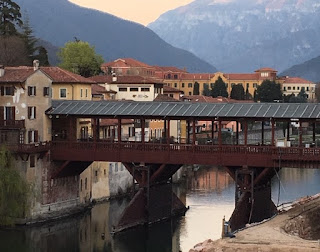Dazzling fresco cycle has survived nearly 700 years
Standing next to the Duomo in Piazza Duomo, Padua’s Baptistery
(Battistero) is a superb example of Romanesque architecture.
The original building was constructed in the 12th century but it was
modified in about 1370 to become a memorial chapel for Francesco il Vecchio di
Carrara and his wife, Fina Buzzacarini.
 |
| The 14th century Baptistery is to the right of the Duomo |
The couple invited the artist Giusto de’ Menabuoi to fresco the interior
with pictures representing stories from the Bible.
De’ Menabuoi, who was originally from Florence, worked on the interior
of the Baptistery between 1376 and 1378. His frescos are remarkable for the brilliance of the colours he used and
the details from the Bible he brings to life.
To understand the cycle of pictures you should ideally stand near the
old entrance to the Baptistery, which was sealed up when the building was
modified. Traces of it can be seen in the structure of arches.
The cycle begins in the cupola with Paradise and finishes in the apse
with the Apocalypse. There are 37 episodes from Genesis that lead on in sequence
to the 43 scenes from the last book of the New Testament.
In the centre of the apse, on a small marble altar, is a Polyptych, also
by De’ Menabuoi, featuring the Madonna and Child, with a picture of the Baptism
of Christ above it, while on either side are panels depicting the stories of
the Saints.
In the panel showing Christ healing the sick, look out for a figure in a
red headdress, which is believed to be a portrait of the poet Petrarch, who
died shortly before the frescos were painted.
Venetian soldiers damaged the Cararra family’s grand burial monuments in
1405 and daubed green paint on the emblems of Francesco il Vecchio, but
restoration work was carried out on the Baptistery in the 20th century.
Visitors to the Baptistery can see how the Duomo would have looked in
the 14th century, before its 16th century makeover, as it appears in De’
Menabuoi’s frescos.
The Baptistery is open from 10 am to 6 pm every day.



